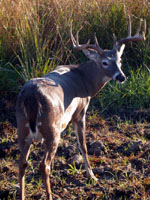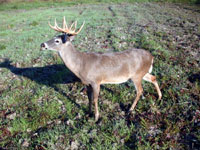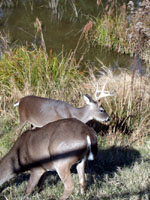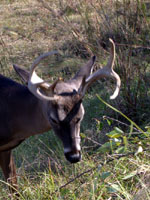
|
Features
|
|
|
|
Books
|
|
|
|
Fun & Games
|
|
|
|
Contact Us
|
|
|
John's Journal... Entry 171, Day 4
ROAD MAP TO WHITETAIL RENDEZVOUSES
Road Maps 9 And 10
 EDITOR'S
NOTE: Bagging a deer can be relatively easy. All
you have to do is have a deer in your sights, know that your scope is
accurate, make a steady squeeze on the trigger and permit your bullet
to do the rest. But finding a white-tailed deer often can be difficult,
although it is the most-plentiful game animal in North America. Here's
some routes to follow that will direct you to a whitetail rendezvous this
winter.
EDITOR'S
NOTE: Bagging a deer can be relatively easy. All
you have to do is have a deer in your sights, know that your scope is
accurate, make a steady squeeze on the trigger and permit your bullet
to do the rest. But finding a white-tailed deer often can be difficult,
although it is the most-plentiful game animal in North America. Here's
some routes to follow that will direct you to a whitetail rendezvous this
winter.
ROAD MAP # 9: Know the best places to hunt a preferred food source according to the time of day.
Since deer are primarily nocturnal feeders, the best time to hunt a preferred food source is either in the morning when the deer are leaving their feeding area or in the afternoon when the animals are returning to their feeding area. "If a hunter moves into a feeding area before daylight or at daylight to take a stand, the chances are extremely good that he will spook the deer already feeding in the region," Shelton says. "The morning hunter will find a better place to hunt if he takes a stand on the trail from the feeding area to the deer's bedding area, or along the route from the food source to thick cover or a bedding site."
 Many
afternoon hunters choose to hunt over green fields or agricultural crops.
These sportsmen will sit on the edges of the fields and wait on the deer
to come from the woods into the fields to eat. However, outdoorsmen who
want to hunt in the afternoon should consider the advice of Ron Fowler
of South Dakota. "The hunter who finds the deer's trail from the woods
to the field and takes a stand 50 to 100 yards in the woods along that
trail will be far more successful in bagging a buck than the hunter who
depends on the deer's coming out into the field. The larger bucks often
will stay 20 to 30 yards in the woods and wait until nightfall before
they come into the fields." So the hunter who meets his buck on the trail
leading to the field may kill a bigger and better buck in his region than
he will if he waits on the deer to step into the field.
Many
afternoon hunters choose to hunt over green fields or agricultural crops.
These sportsmen will sit on the edges of the fields and wait on the deer
to come from the woods into the fields to eat. However, outdoorsmen who
want to hunt in the afternoon should consider the advice of Ron Fowler
of South Dakota. "The hunter who finds the deer's trail from the woods
to the field and takes a stand 50 to 100 yards in the woods along that
trail will be far more successful in bagging a buck than the hunter who
depends on the deer's coming out into the field. The larger bucks often
will stay 20 to 30 yards in the woods and wait until nightfall before
they come into the fields." So the hunter who meets his buck on the trail
leading to the field may kill a bigger and better buck in his region than
he will if he waits on the deer to step into the field.
ROAD MAP # 10: Find escape routes from fields and bedding areas, and plan a spook hunt.
 Many
hunters disregard bedding sites as places to meet a buck. And of course
the chances of taking deer in the bed are remote. However, by knowing
where deer bed, a hunter can look for escape routes (trails whitetails
travel when they are spooked), because an excellent method for bagging
a buck is employing the tactic of spook hunting. Bedding sites can be
distinguished by leaves or grass packed-down in the outline of a deer's
body, or in soft snow by a depression in the snow showing dry leaves in
the bottom of the bed where the deer has scraped the snow away. By mid-morning
the deer will have fed and bedded-down. Although the deer, a ruminant,
can eat his fill in an hour, due to his compartmentalized stomach, he
will bed-down in a safe place, regurgitate the partially-chewed food and
rechew it. One hunter can take a stand along a deer's escape route from
the bedding site. The second hunter can walk boldly into the bedding site
from the opposite direction of the first hunter to spook a buck and make
him run down the escape trail and into the sights of the first hunter.
Many
hunters disregard bedding sites as places to meet a buck. And of course
the chances of taking deer in the bed are remote. However, by knowing
where deer bed, a hunter can look for escape routes (trails whitetails
travel when they are spooked), because an excellent method for bagging
a buck is employing the tactic of spook hunting. Bedding sites can be
distinguished by leaves or grass packed-down in the outline of a deer's
body, or in soft snow by a depression in the snow showing dry leaves in
the bottom of the bed where the deer has scraped the snow away. By mid-morning
the deer will have fed and bedded-down. Although the deer, a ruminant,
can eat his fill in an hour, due to his compartmentalized stomach, he
will bed-down in a safe place, regurgitate the partially-chewed food and
rechew it. One hunter can take a stand along a deer's escape route from
the bedding site. The second hunter can walk boldly into the bedding site
from the opposite direction of the first hunter to spook a buck and make
him run down the escape trail and into the sights of the first hunter.
Spook hunting also is successful on ornery field deer. These deer always are standing in the fields when hunters pass by but never allow sportsmen to get within gun range. I remember the soybean field buck I hunted a few seasons ago. As I approached the field, I saw his high rack and large body at the edge of the field. Each time I approached, the buck left the field by an escape trail. I tried taking a stand on this trail in the morning and evening. But the buck never appeared. However each time I spooked the deer from the field, he ran along this trail. I convinced a friend to help me bag this fine buck. We crawled up to the edge of the field and saw the white antlers above the beans.
 "Give
me 30 minutes," I told my companion. "Then stand up and walk toward the
deer." During the next 30 minutes I circled the field, found the escape
trail and positioned myself 50 yards in the woods from the field and 30
yards from the trail. "I should be able to see the buck from here," I
thought. As I looked at my watch for the first time, I heard the beans
swishing and saw the buck on the run. Twenty yards from the field, he
slowed his gait and began to walk down the escape trail and right into
the center of my scope. I squeezed the trigger. The fat beanfield buck
dropped. By knowing the trail a deer plies to escape danger, hunters may
be able to more-specifically pinpoint the crossroads where they will meet
bucks.
"Give
me 30 minutes," I told my companion. "Then stand up and walk toward the
deer." During the next 30 minutes I circled the field, found the escape
trail and positioned myself 50 yards in the woods from the field and 30
yards from the trail. "I should be able to see the buck from here," I
thought. As I looked at my watch for the first time, I heard the beans
swishing and saw the buck on the run. Twenty yards from the field, he
slowed his gait and began to walk down the escape trail and right into
the center of my scope. I squeezed the trigger. The fat beanfield buck
dropped. By knowing the trail a deer plies to escape danger, hunters may
be able to more-specifically pinpoint the crossroads where they will meet
bucks.
TOMORROW: ROAD MAPS 11 AND 12
Check back each day this week for more about ROAD MAP TO WHITETAIL RENDEZVOUSES ...
Day 1 - Finding Your Deer
Day 2 - Road Maps 3-5
Day 3 - Road Maps 6-8
Day 4 - Road Maps 9 and 10
Day 5 - Road Maps 11 and 12